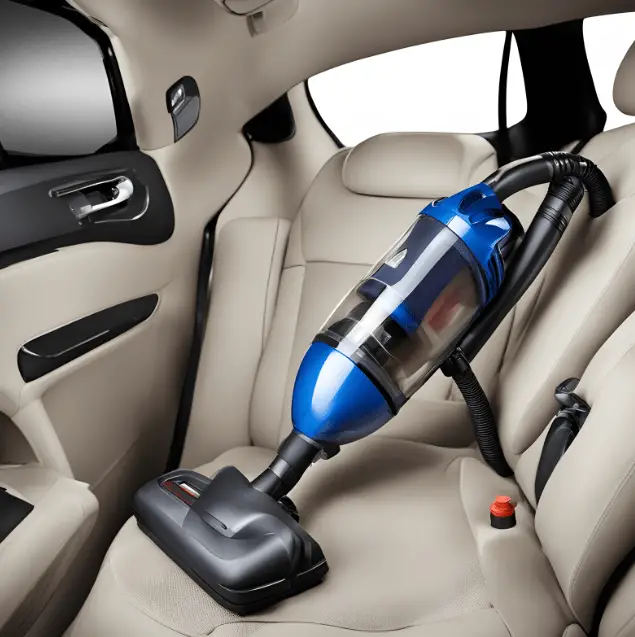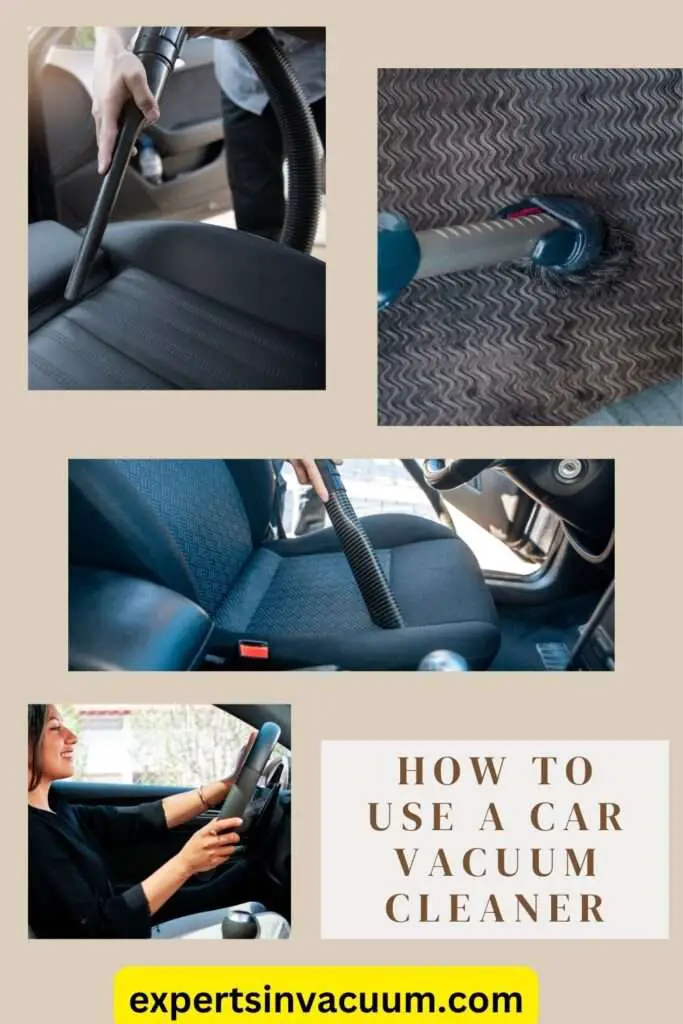When you use a car vacuum cleaner, getting your cleaning done faster implies something quite different. A car vacuum cleaner takes your cleaning game to a whole new level, much as your trusty car does while you’re driving down the highway.
Crumbs and dust will no longer hide between chairs or settle in like unwanted guests. Using a car vacuum cleaner will not only ensure that the inside of your automobile is pristine, but it will also elevate regular cleaning to the level of an art form.

In this article, we will go through the ups and downs of utilizing a car vacuum cleaner. The ultimate goal is to create a pristine haven on wheels.
In this post we will cover:
- How to use a car Vacuum cleaner
- The proper way to connect a car vacuum cleaner to the power source
- Can I use a regular household vacuum cleaner for my car?
- What attachments come with a car vacuum cleaner?
- How often should I vacuum my car’s interior?
How to use a car Vacuum cleaner
Effectively using a car vacuum cleaner is a simple technique that keeps the interior of your vehicle clean and enjoyable. First, choose a time when you will not be rushed and can concentrate on this task. Park your car somewhere well-lit, preferably outside, to make cleaning easier.
Step 1: Open all of the car doors to make getting in and out easier and to allow more air to flow. Before you start the vacuum cleaner, take a moment to remove any large items or debris from the car’s seats, floor mats, and storage areas.
This first step prevents the vacuum cleaner from becoming stuck and improves its performance.
Step 2: Connect the vacuum cleaner’s line to the appropriate nozzle or attachment. There are attachments for various surfaces, such as carpets, cloth seats, and tight areas.
Begin by cleaning the seats and floor mats from the top and working your way down. Use light strokes and take your time to ensure that the vacuum cleaner picks up all of the dirt and dust.
Cracks, seams, and the area surrounding the pedals should be treated with extra caution. Use the vacuum’s tiny nozzle or crevice tool to access these difficult-to-reach areas.
Step 3: Remove the floor mats from the vehicle and thoroughly clean both sides. When you come to the rugs, repeat the process from top to bottom, making sure to cover every area in the same manner.
If you work in small groups, you can clean more thoroughly. You can gently tap the carpet to release dirt or debris that will not come up with a cleaner.
Step 4: After you’ve completed the seats, floor mats, and carpets, proceed to the dashboard, center panel, and storage places. Use a soft brush adapter to avoid scratching fragile surfaces. A smaller nozzle can effectively remove dust that has accumulated in air vents and confined places.
Step 5: Finally, after vacuuming every surface within the car, turn off the vacuum and inspect the vehicle for any missed locations.
If necessary, repeat this process in these locations until you are satisfied with the outcomes. When you are finished, remove the gadgets and store them properly for future use.
Conclusion
The car vacuum cleaner is an unsung hero in the hunt for flawless cars, transforming the tedious chore of cleaning into a journey of restoration.
Keep in mind that its power isn’t just for removing rubbish; it’s also a link between you and your car, a bridge that recounts memories of remarkable adventures you’ve had together.
The exceptional care you give your car now will stay forever, leaving an indelible stamp on the places you’ve driven and the stories you still have to write, just as the things we do in life form us.
FAQs
What is the proper way to connect a car vacuum cleaner to the power source?
Connecting a car vacuum cleaner to a power source must be done carefully and cautiously to ensure that it operates properly and protects the operator.
First, locate the vacuum cleaner’s power line and the corresponding power outlet in your vehicle. Unwind the cord slowly so that it does not become tangled or kinked, which could damage it.
Put the power plug into the car’s power outlet with a firm grip, making sure it fits snugly but not too tightly. To avoid any damage, ensure that the plug is properly oriented and lined up. When the plug is properly connected, you should feel some resistance as it settles in.
Avoid plugging in too many gadgets or extensions at once, as this may cause the power to run out or constitute a safety concern. Also, avoid twisting or bending the cord at acute angles, since this may cause damage to the wires inside.
Put safety first by inspecting the cord for shredding, cuts, or protruding wires. If these issues are discovered, do not connect the vacuum cleaner and instead consider having it repaired by a professional or purchasing a new one.
Can I use a regular household vacuum cleaner for my car?
When it comes to car care, you may wonder whether a standard home vacuum cleaner is adequate. Several factors influence whether or not a standard household vacuum cleaner can be used to clean the interior of a car.
One of these considerations is the suction power. Another advantage is the adaptability of the attachments.
Finally, the maneuverability of a car. Some household vacuum cleaners may be capable of this, but it’s crucial to consider what your car requires in terms of cleaning, such as removing dirt, debris, and pet hair from the carpets, furnishings, and gaps.
A vacuum cleaner designed exclusively for cars may be more beneficial and simple to operate, and it will clean your car’s inside more thoroughly and quickly.
What attachments come with a car vacuum cleaner, and how are they used?
Crevice Tool: This slim, elongated attachment is great for reaching between seats, along edges, and in corners. It aids in dislodging and extracting dirt that would otherwise be difficult to reach.
Brush Tool: The bristles on the brush attachment are gentle on surfaces while effectively removing dirt and debris. It can be used to clean dashboards, upholstery, and delicate areas without causing any damage.
Upholstery Tool: This attachment is ideal for cleaning larger areas, such as vehicle seats and rugs, because it has a wider head and often a soft fabric strip. It ensures that the furniture is thoroughly cleaned and secured.
Extension Wand: You can reach further with the vacuum cleaner and clean behind seats, inside storage spaces, and other difficult-to-reach areas with an extension wand.
Dusting Brush: It includes gentle bristles that can remove dust and grime off vents, knobs, and other delicate surfaces without scratching or harming them.
Flexible Hose: A flexible hose allows the vacuum to go into tight spaces and clean at angles that would otherwise be difficult to reach.
You use these by attaching them to the end of the vacuum’s hose or stick. The attachment that you choose and how tightly you connect it will depend on the type of cleaning.
How often should I vacuum my car’s interior?
Keeping the inside of your car clean and comfy is essential for a pleasant driving experience. Regular vacuuming is a vital aspect of this upkeep since it removes dirt, trash, and particles that accumulate over time.
The frequency with which you clean the inside of your car is influenced by factors like as how frequently you use it, the weather where you live, and what you do inside the car.
Situations with a lot of foot activity, pets, and frequent eating in the car can cause the mess to pile up faster, necessitating more frequent vacuuming. If, on the other hand, you just drive short distances and keep your car clean, you may be able to go longer between cleaning sessions.
You should choose how frequently you should perform this maintenance task by balancing your lifestyle needs with your goal for a clean and pleasant driving environment.
Cleaning your car with a vacuum on a regular basis not only improves its appearance, but it also makes it healthier for you and your passengers.
What are some common mistakes to avoid when using a car vacuum cleaner?
When using a car vacuum cleaner, there are numerous mistakes that you may make that may damage the equipment or cause it to last less than it should.
One critical error to avoid is failing to prepare the interior of the vehicle before cleaning it. Clogs and reduced suction power might result from not removing larger pieces of trash or debris.
Cleaning can be less effective if you do not pay attention to the vacuum’s attachments and settings. It’s critical to select the perfect balance of power and gentleness, since too much force can damage sensitive surfaces and too low a setting can prevent the vacuum from working.
Another common error is failing to pay attention to the vacuum’s filter. The vacuum’s performance and the quality of the air inside the car can suffer if the filter is not replaced or cleaned on a regular basis.
It might also be inconvenient to forget where the vacuum’s power comes from. Inadequate power or dead batteries might make cleaning more difficult, so ensure there is a consistent source of power.
Not getting into difficult-to-reach or secret areas is a mistake that can harm both the cleaning process and the interior of the vehicle. If you avoid these areas, you may just clean a portion of the car, making it appear less spectacular overall.
Finally, if you do not properly store the vacuum after use, it may break down or become damaged over time. Placing it somewhere dry and dust-free can help it live longer and work better.
